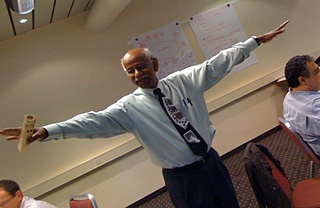THIAGI GAMELETTER:
March 2011
SERIOUSLY FUN ACTIVITIES FOR TRAINERS, FACILITATORS,
PERFORMANCE CONSULTANTS, AND MANAGERS.
TABLE OF CONTENTS
Masthead
Our mission statement, copyright notice, and cast
of characters.
Commentary
Training Objectives
Benefits and shortcomings.
Live Online Learning Activity
25 Strategies for Increasing Interactivity in Virtual
Classrooms
Beyond talking-head webinars.
Jolt
Solve a Mini Sudoku
Avoid unnecessary assumptions.
Jolt 2
Paper Folding by Tracy Tagliati
Paper fold your way to outer space.
Creativity Activity
Transformers by Tracy Tagliati
Exercise your creative muscles.
Say It Quick
Wasting Work Time by Brian Remer
I never waste time at work.
Discoveries
Book Review by Brian Remer
Where Good Ideas Come From
by Steven Johnson.
Ideas
Creating Innovative Flow by Brian Remer
The importance of liquid networks.
Activities
Your Next Brilliant Idea by Brian Remer
How to foster your own liquid
network.
Dallas Workshops
Interactive Techniques for Instructor-Led
Training
Public workshops in the USA.
Zurich Workshops
Thiagi and Sam in Zurich
Public workshops in Europe.
Single Topic Survey
The Global Classroom Paradox by Tracy Tagliati
Where in the world are your
participants?
Survey Results
Do You Use Mnemonics? by Tracy Tagliati
A summary of your responses.
Bookshelf
Book Recommendations
Evidence-based psychology, partnership principles,
and presentation skills.
Masthead
THIAGI GAMELETTER:
SERIOUSLY FUN ACTIVITIES FOR TRAINERS, FACILITATORS,
PERFORMANCE CONSULTANTS, AND MANAGERS.
Mission
To increase and improve the use of interactive,
experiential strategies to improve human performance in an
effective, efficient, and enjoyable way.
Editorial Roster
 Author and Editor
: Sivasailam (Thiagi) Thiagarajan
Author and Editor
: Sivasailam (Thiagi) Thiagarajan
 Assistant Editor
: Raja Thiagarajan
Assistant Editor
: Raja Thiagarajan
Associate Editors: Tracy Tagliati and Jean Reese
Contributing Editors: Brian Remer and Matthew Richter
Editorial Advisory Board: Bill Wake, Matthew Richter, Samuel van den Bergh, and <type your name here>
Copyright Info
The materials in this newsletter are copyright 2011 by The
Thiagi Group. However, they may be freely reproduced for
educational/training activities. There is no need to obtain
special permission for such use as long as you do not
reproduce more than 100 copies per year. Please
include the following statement on all reproductions:
Reprinted from THIAGI GAMELETTER. Copyright © 2011
by The Thiagi Group, Inc.
For any other use of the content, please contact us (
thiagi@thiagi.com ) for permission.
Subscription Info
To sign up, or to donate and help us continue this
newsletter, please see the Online
Newsletter page on our website (
http://thiagi.com/pfp.html ).
Feedback Request
Thiagi believes in practicing what he preaches. This is an
interactive newsletter, so interact already! Send us your
feedback, sarcastic remarks, and gratuitous advice through
email to thiagi@thiagi.com . Thanks!
[Table of Contents]
Commentary
Training Objectives
According to Robert Gagné, an eminent instructional
psychologist, one of the first things that you should do
during a training session is to announce your objectives.
Let's explore how this guideline impacts on the design and use
of training games.
The benefits of specifying your objectives at the beginning
of a training session are obvious:
- You motivate participants by providing them with a
desirable goal that they would like to achieve.
- You align participants' expectations with your
intentions. Participants understand where you are taking
them. During the learning journey, they continuously measure
their progress toward this destination.
- You provide a preview of things to come. This permits
participants to selectively listen, take notes, and practice
to master relevant skills and knowledge.
Specifying your objectives at the beginning of a training
session has some shortcomings too:
- You may encourage participants to ignore personally
meaningful insights just because they are unrelated to your
objectives.
- You may increase participants' anxiety level, especially
if you state your objectives in incomprehensible technical
jargon.
- You may confuse participants by presenting too many
details about the behavioral outcomes, conditions, and
required standards.
- All learning involves change in behavior. Some changes
bring out resistance. Therefore, by emphasizing behavior
changes in your objectives, you may increase participant
resistance.
- By revealing the training objective, you may remove one
of the most joyful elements of learning—the element
of discovery.
What's In It for the Participant?
Let's explore strategies for avoiding the shortcoming and
guaranteeing the benefits of specifying objectives at the
beginning of your training session.
Most of us have been taught to state training objectives as
specific, measurable behavioral outcomes. We have been told
that a complete objective should include the participant's
behavior, the conditions under which this behavior is to be
demonstrated, and the minimal standards for an acceptable
behavior. As a result, we end up stating our training
objectives in legalistic terms such as these:
At the end of this training session, given a set of 10
simultaneous algebraic equations involving two unknown
variables, the learner will be able to correctly solve at
least 8 of them, within 10 minutes, and without using any
references or calculators.
Upon completion of the training session, without using
any reference materials on sexual harassment, the learner
will be able to provide the correct definition of a
hostile work environment and list at least three legal
consequences of not taking corrective action with regard
to such an environment.
These statements of objectives are useful—for an
instructional designer or an evaluator. However, if you
begin a training session by sprouting statements in this
form, you are more likely to increase participants' levels
of anxiety and confusion rather than their level of
motivation.
The best strategy for presenting your training objective is
to focus on the benefits for participants. Also, plain
language is more important than precise language. So why not
begin your training session with statements of objectives
such as these?
Want to impress your friends at the next party? Want to
win bar bets? You are going to learn how to solve puzzles
such as this: “You and I have a total of 14 dollars. If
you give me 3 dollars, we will both have the same amount
of money. How much money do you have now?”
Want to avoid expensive lawsuits and negative performance
reviews? Find out how your “harmless” jokes and the
“funny” cartoons on your bulletin board can result
in a telephone call from a lawyer.
Most participants would prefer these playful statements to
the earlier specifications of the same objectives. If you
feel uncomfortable about leaving out details, remember that
you can return to your objectives later in your training
session and make them more precise.
Playing With Training Objectives
Instead of reciting the training objectives or asking
participants to read a printed version, why not let them
experience the objectives through a brief game? Here are a
couple of samples based on the two training objectives
presented earlier:
Stump the expert. Present this puzzle:
You and I have a total of 120 dollars. You have 20
dollars more than me. How much money do you have?
Invite participants to yell out the answer. Most people
would say $60 or $80. Both of these answers are incorrect.
Give the correct answer ($70). Now give 3 minutes for
participants to create their own puzzles using the same
format. Ask them to take turns to present their puzzles.
Immediately give the answer (using the technique that you
are going to teach them). After participants are suitably
impressed, specify the training objective by saying that
they too would be able to solve these types of puzzles
rapidly and correctly.
You be the judge. Distribute a handout
with half-a-dozen summary descriptions of sexual harassment
lawsuits involving a hostile work environment. Ask
participants to guess the penalties awarded in each case.
Give the correct answers (which would surprise most
participants). Specify the training objective by saying that
participants are going to learn how to avoid heavy legal
penalties.
Hiding the Training Objective
The effectiveness of many roleplays, simulation games, and
jolts require participants to behave according to their
natural inclination—and then discover how their
assumptions and habits contributed to dysfunctional
behaviors. In situations like this, announcing the objective
in advance will obviously defeat the purpose of the
training. There cannot be any self-discovery when
participants are told what they should discover. With
training games that hold up a mirror to participants and
increase their awareness of assumptions, stereotypes,
prejudices, attitudes, beliefs, and values, you may consider
withholding the training objectives. However, you should
reveal your objectives and discuss them in detail during the
debriefing session.
Here's a summary checklist of our discussion about training
objectives and training games:
- Informing participants about your objectives at the
beginning of a training session provides some benefits and
creates some problems.
- Mechanical recitation of training objectives according
to some standard formula may create confusion and
anxiety.
- Present training objectives in terms of benefits to
participants.
- Invite participants to experience the objectives
through a short game.
- In situations where self-discovery is important, delay
the sharing of training objectives until the debriefing
discussion at the conclusion of an experiential
activity.
[Table of Contents]
Live Online Learning Activity
25 Strategies for Increasing Interactivity in Virtual
Classrooms
An increasing number of our clients ask us to deliver
training workshops as webinars instead of face-to-face
sessions. They have apparently arrived at this objective
decision by applying a single criterion: reducing cost. Our
clients are also satisfied with talking head sessions (minus
the talking head) that use a barrage of PowerPoint slides to
dump data. However, we feel guilty about this approach since
it's the adult equivalent of taking candy from a baby. So we
have been experimenting with increasing interactivity in our
virtual classrooms as an approach to improving instructional
effectiveness. We “ported” several interactive classroom
strategies, dropped some of them, and adapted the others to
leverage the online environment.
Here's our list of 25 interactive strategies for live online
learning. Remember, we are instructional designers and not
technology gurus. Hence these approaches are platform-agnostic
and use the commonest webinar features.
-
Assessment-Based Learning Activities (ABLAs)
require participants to complete an online test, a rating
scale, or a questionnaire and score their own performance. In
the test-first approach, the facilitator focuses on the items
that were missed by the participants.
-
Brain-Pick Activity. This activity involves
four or five “informants” who have significant
experience and expertise in the training topic. The
participants are divided into as many teams as there are
informants and assigned to separate breakout rooms. The
informants rotate around the rooms where they are
interviewed by the team members. At the end of the
interviews, each team prepares and presents a summary of
what they learned from the informants.
-
Case Method begins with an audio or text
display of a real or fictional scenario surrounding a
problem. By typing text messages, the participants analyze,
discuss, make decisions, and apply concepts and principles
associated with the case. The facilitator adds additional
insights and removes any misconceptions.
-
Closers are activities conducted near the
end of the online learning session. They use interactive
discussions for reviewing main points, tying up loose ends,
planning application activities, providing feedback,
celebrating successful conclusion, and exchanging
information for future contacts.
-
Consensus Decisionmaking Activities involve
a list of items (usually 10) to be arranged in order of
priority. Participants send text messages to each other and
then reach a consensus. The facilitator presents priority
rankings from an expert and invites participants to discuss
any differences.
-
Debriefing Activities are used for
encouraging reflection and dialogue about an earlier
experience from the workplace or a training activity (such
as a roleplay or a simulation game). These activities
involve processing of the common experience through a
typed-chat discussion to extract key learning points from
it. They encourage participants to identify and express
their feelings, recall events and decisions, share the
lessons they learned, relate insights to other real-world
events, speculate on how things could have been different,
and plan for future action.
-
Double Exposure Activities present training
videos or audio recordings. The participants watch a segment
or listen to a segment and then interact with each other
through typed-chat discussions to review and apply the new
concepts and skills.
-
Graphics Games involve photographs,
paintings, drawings, or cartoons as an essential element.
Some graphic games require participants to create these
graphics. In other games, the participants review the
graphic, analyze its elements, discover relationships, and
discuss their findings.
-
Improv Games increase the participants'
fluency with concepts and terms. Most improve games require
the participants to type-chat responses to open questions
their ability to recall key information and to think
creatively and spontaneously.
-
Instructional Puzzles challenge the
participant's ingenuity and incorporate training content
that is to be previewed, reviewed, tested, re-taught, or
enriched. They can also be used to train people on different
types of thinking skills.
-
Interactive Lectures involve participants
in the learning process while providing complete control to
the online facilitator. These activities enable a quick and
easy conversion of a passive presentation into an
interactive experience. Different types of interactive
lectures incorporate built-in quizzes, interspersed tasks,
teamwork interludes, and participant control of the
presentation.
-
Interactive Storytelling involves fictional
narratives in a variety of forms. Participants may listen to
a story and make appropriate decisions at critical
junctures. They may also create and share stories that
illustrate key concepts, steps, or principles related the
instructional objective.
-
Item Processing activities begin with a
display of guidelines, principles, facts, questions, or
suggestions. By text-chatting with each other, the
participants organize these items into appropriate
categories.
-
Jolts lull participants into behaving in a
comfortable way and deliver a powerful wake-up call. They
force participants to re-examine their assumptions and
revise their standard procedures. Online jolts typically
last for a few minutes but provide enough insights for a
lengthy debriefing.
-
Magic Tricks incorporate an online
conjuring trick as a part of a training session. These
tricks provide metaphors or analogies for important elements
of the training content. They are also used as processes to
be analyzed, reconstructed, learned, performed, or coached
for training participants in appropriate procedures.
-
Matrix Games require participants to type
the content in boxes of a grid displayed on the screen. The
activity could be designed as a contest between individuals
or teams to supply the most appropriate response for each
box.
-
Openers are live online activities
conducted near the beginning of a training session. They use
interactive strategies to preview main points, orient
participants, introduce participants to one another, form
teams, establish ground rules, set goals, reduce initial
anxieties, or stimulate self-disclosure.
-
Pair Work involves two people working on
the same whiteboard to provide a joint response to a
question. This strategy could be used at the beginning of an
online session or at the end to provide a review.
-
Reflective Teamwork involves participants
typing suggestions for a checklist on some aspect of online
collaboration. Teams then evaluate their own performance by
using the product they created.
-
Roleplays can be easily conducted in a live
online session. The participants can be paired up to
type-chat with each other or two volunteers can use their
microphones to conduct an audio roleplay. Other participants
may type their comments and coaching suggestions.
-
Sampling Activities present a collection of
different examples (such as email subject
lines, conference session descriptions,
lead paragraphs of articles, or names
of popular products). Through text-chat messages,
participants analyze the samples, arrange them in different
groups and sequences, identify key features, and list
quality standards. Later, they apply their discoveries to
create new products that meet their needs and conform to the
standards.
-
Structured Sharing activities require and
reward mutual learning and teaching among participants
through text-chats. These activities create a context for a
dialogue among participants based on their experiences,
knowledge, and opinions.
-
Textra Activities combine the effective
organization of well-written documents with the motivational
impact of interactive strategies. Participants read short
messages on the screen or longer documents that are
downloaded. Later, they participate in an interactive
exercise that uses peer pressure and peer support to
encourage recall and transfer of what they read.
-
Troubleshooting Simulations can be used
with technical topics and interpersonal concepts. They begin
with a scenario presented by the online facilitator,
supplemented by displays of instrument readouts. The
participants suggest tests and the facilitator provides
appropriate data. The process is repeated until the cause of
the trouble is identified. The activity is followed by an
online debriefing discussion.
-
Values Clarification uses forced choices,
provocative issues, and confrontation of participants'
inconsistencies. The strategy helps individual participants
to decide among alternatives and determine what has personal
meaning. The process does not force one set of right values
but rather encourages discussion and exploration of
alternatives before choosing a specific value.
Coming Soon
We will explore these interactive strategies in future
issues of TGL.
[Table of Contents]
Jolt
Solve a Mini Sudoku
Here's a jolt that incorporates a puzzle.
Synopsis
Each person gets a copy of a mini sudoku puzzle with an
extra number as a clue. Participants assume that it is an
individual test and try to solve it independently.
Facilitator points out that if they had cooperated with each
other they could have compared the different clues and
quickly solved the puzzle.
Purpose
To challenge the fallacies of assuming that everyone begins
with identical resources and that all tasks have to be
completed independently.
Training Topics
- Teamwork
- Cooperation
- Assumptions
Participants
5 or more.
This jolt works best with larger groups of 20 to 30.
Time
3 minutes for the activity and 3 minutes for
debriefing.
Supplies
Handouts
-
Sample
mini Sudoku puzzle (64K PDF) with instructions
and solution.
-
Difficult mini Sudoku puzzle (39K PDF), one copy
for each participant. (Each copy is slightly different;
for more information, see the Preparation
section.)
Preparation
Print a copy of the sample mini Sudoku puzzle and learn to
solve it. (Later, you will be explaining the procedure to
the participants.)
Prepare copies of this sample for each participant.
Print a copy of the difficult puzzle and try to solve it.
It can be solved, but it is a fairly difficult puzzle.
Prepare individual handouts for each participant. Estimate
the number of people who will be attending your session. Run
off that many copies. Each puzzle has 12 numbers already
printed in appropriate spaces.
Add one extra number to each copy of the puzzle. Use the
solution below to write a different number on each
handout. Since there are 24 blank spaces in the original
puzzle, you can prepare 24 different versions. If you expect
more than 24 people, cycle through the numbers again.
| 6 |
2 |
3 |
4 |
1 |
5 |
| 4 |
1 |
5 |
6 |
2 |
3 |
| 5 |
6 |
1 |
2 |
3 |
4 |
| 2 |
3 |
4 |
1 |
5 |
6 |
Flow
Demonstrate how to solve mini Sudoku
puzzles. Distribute the sample mini Sudoku puzzle
and explain how to solve it. Point to different spaces in
the puzzle and invite participants to yell out the number
that goes there.
Brief the players. After the
demonstration, distribute copies of the difficult mini
Sudoku puzzle and explain that this one is a test and it is
a tougher puzzle to solve. Explain that you have started off
the solution by writing down a number in its correct
location. Tell the participants, “Let's see how fast you
all can solve this puzzle.”
Keep your mouth shut. If anyone asks you a
question, just reply, “You are on your own!”
End the session. After about 2 minutes,
blow the whistle and act surprised that the puzzle is not
yet solved. Explain that the previous groups had solved the
puzzle by this time.
Explain the situation. Point out that this
was actually a test of the participants' ability to
collaborate with each other. Explain that each participant
had a different extra number and if all the participants had
shared the information and worked with each other, they
could have easily and rapidly solved the puzzle.
Debriefing
Elicit the assumptions that participants
made. Ask what prevented them from collaborating
with each other. Probe to ferret out these types of
assumptions:
- All puzzles have to be completed independently.
- Everyone has the same extra number.
- We are competing with each other.
Recall your instructions. If the
participants accuse you of setting them up, point out that
your final instruction was, “Let's see how fast
you all can solve this puzzle.”
Learning Points
- Don't assume that everyone begins from the same place.
Even if all the participants had identical handouts, they
still bring different experiences, expertise, perceptions,
logic, and work styles.
- Don't assume that you have to complete all your tasks
independently. Change your default assumption to treating
all tasks as collaborative endeavors. Be quick to ask
for—and offer—help.
Follow Up
You can find more mini-sudoku puzzles at these
websites:
[Table of Contents]
Jolt 2
Paper Folding
by Tracy Tagliati

Synopsis
Participants take a sheet of paper and are asked to
repeatedly fold it in half. When they can no longer fold the
paper they are asked to predict how many folds they would
have to make to reach specific distances.
Purpose
To convince participants about the speed of exponential
growth.
Topics
- Word of mouth marketing
- Pay-it forward
- Procrastination
- Change management
- Population growth
- Compound interest
Participants
One or more.
Time
3 minutes for the activity, 5 minutes for the
debriefing.
Supplies
One piece of paper, napkin, or paper towel for each
person.
Preparation
Consider creating PowerPoint™ slides.
Flow
Fold paper in half. Distribute a piece of
paper to each participant and ask them to fold it in half.
Then, ask them to fold it half a second time, then a third
time, and continuing counting and folding as much as they
can. Most people will be able to do 7 folds. This is about a
half an inch or the thickness of a spiral notebook.
Make a prediction. Ask the participants to
use their folded paper as a reference and write their
prediction for how many folds it would take for a folded
piece of paper to be the width of an average person's hand
(including the thumb). Then ask them to write and predict
how many folds it would take for a folded piece of paper to
be as tall as a four story building. Finally ask them to
write and predict how many folds it would take for a folded
piece of paper to reach the outer limits of the solar
system.
Reveal the answers. After the participants
have written their predictions, reveal to them the correct
answers. An average hand would take 10 folds, a four-story
building would take 17 folds (42 feet), and it would take
only 30 folds to reach the edge of outer space (66
miles).
Explain the concept of exponential growth.
Of course it is not physically possible to fold a piece of
paper that many times, but still most people will be shocked
to discover these facts and they may think you are tricking
them.
Explain exponential nature of paper folding by pointing out
that each time you fold the paper in half, the thickness of
the paper layer is doubled. Give a calculator to one of the
participants ask her to multiply 2 by 2. Have her multiply
the product (4) by 2 and continue multiplying the ensuing
products repeatedly by 2. Keep counting the number of times
the product is multiplied by 2. Point out that product keeps
increasing rapidly as you move into larger numbers. Very
soon, the number will overflow the capacity of calculator's
display.
Debrief. Ask the participants how the
exponential growth of paper folding relates to different
events the workplace (word of mouth marketing, pay-it
forward, procrastination, and compound interest)?
Ask the participants what things they should do to take
advantage of the power of exponential growth.
In the case of negative word of mouth comments, ask the
participants what they should avoid doing because of the
power of exponential growth.
Learning Point
Small things can turn into huge things because of
exponential growth.
[Table of Contents]
Creativity Activity
Transformers
by Tracy Tagliati

Purpose
- Encourage creative thinking.
- Find new uses and markets for a company's current
products.
Participants
Any number.
Time
5 to 10 minutes.
Supplies
A collection of random items such as a coffee filter, a
paper clip, a Ziploc bag, and a current product from your
company.
Flow
Explain the activity. Introduce one of the
random items (example: a coffee filter). Ask the
participants to write a list of as many possible alternative
uses for the item that they can think of in the next 3
minutes.
Share ideas and compute scores. After 3
minutes, blow your whistle and ask the participants to stop
writing. Share your list of alternative uses for the random
item with the group (examples: line a plant pot, clean eye
glasses, provide separators between fine china dishes, cover
dishes being cooked in a microwave oven). Tell the
participants to give themselves one point for each original
idea they have on their list that you have not
mentioned.
Acknowledge high scoring participants. Ask
if anyone has a personal score higher than 20. Count down
until you identify the person with the highest score. Ask
that person to share her unique ideas. Ask the group if
anyone else has a unique idea that has not yet been
shared.
Introduce a new item. Continue the
activity as before until you run out of time. Be sure to
introduce the company product during the last round.
[Table of Contents]
Say It Quick
Wasting Work Time
by Brian Remer
Great new ideas are all around us waiting to be discovered!
If you are having trouble finding them, this month's pieces
may be of help beginning with this 99-Word Story.
Wasting Work Time
Listening to the radio, I heard that Americans waste an
average of 2 hours at work every day. That translates into
$759 billion lost!
Me? I never waste time at work. I'm too busy making
connections, building social capital. A walk to the water
cooler puts me in touch with other people, their projects,
their problems, and their needs. Even the physical act of
moving gets my brain working in different ways, exploring
new paths. I always return to my desk with several new
ideas.
Perhaps we ought to redefine “work” and how we value
it!
[Table of Contents]
Discoveries
Book Review
by Brian Remer
“How did they ever think of that?”
This was a phrase I often heard from my mother. It expressed
her awe about brilliant innovations whenever she saw them. It
also expresses the common perception that new ideas come to us
out of thin air.
In his book Where Good Ideas Come
From, Steven Johnson dispels this myth by offering
a historical perspective on how new ideas are conceived,
evolve, and take root in society. Instead of brilliant ideas
coming to us out of the ether, Johnson explains that each
innovation is build upon previous ideas. New concepts are
always cobbled together. Each idea actually uses previous
innovations as its building blocks. And some ideas are even
ahead of their time because there isn't the political, social,
or physical infrastructure in place to support them. The
earliest programmable computer was conceived and designed by
Charles Babbage in the 1870's but it couldn't actually be
built out of the mechanical gears available at the time. The
idea had to wait until the vacuum tube was invented nearly 100
years later!
Johnson uses much of his book to describe the type of
environment most conducive to innovation. He backs that
description up with extensive historical examples. An
innovation-ripe environment…
- Provides open access to ideas
- Encourages ideas to be recombined in novel ways.
- Uses large, malleable networks to share
information.
- Allows time for a hunch to develop and become connected
to other concepts.
- Tolerates ambiguity and a bit of chaos to foster
serendipity.
- Welcomes errors that lead to further
experimentation.
- Takes concepts from one field and applies them to
another.
- Creates a framework or set of standards that can become
the foundation for further innovation.
Johnson also challenges the common notion that the
competitive marketplace is the best environment for new ideas.
Because competition typically has to do with developing ideas
that are marketable, a market-driven innovation may be
shrouded in secrecy by patents and copyrights. While these
laws do protect the intellectual property of the inventor,
they set up barriers that prevent further innovation by
limiting the free exchange of ideas that can produce synergy.
Profit is sometimes a motivation for innovation, says Johnson,
but it is not the biggest source of new ideas. A university
research environment is typically more conducive to
paradigm-shifting innovations.
The book includes an informative Chronology of Key
Innovations, 1400 - 2000 which provides helpful perspective
for people who, like my mother, are dazzled by innovation.
Whether you want to shift a paradigm or energize your own
creative process, you'll find ideas, inspiration, and
historical examples in Where Good Ideas Come
From, © 2010 Steven Johnson, Riverhead
Books, ISBN 978-1-59448-771-2.
(Click the cover below to see the book on Amazon.com. We receive a small
commission if you buy the book from Amazon.)
![[Book Cover]](../amazon/51bfJbi7uaL._SL160_.jpg)
[Table of Contents]
Ideas
Creating Innovative Flow
by Brian Remer
The 99-Word story this month suggests that whether what we
are doing at work is wasteful or productive depends upon our
definition of what work is. There is a lot that could be
happening around the expected work tasks that
actually makes a huge contribution to the real work
that eventually gets done.
The same could be said for creativity: it's not an activity
that fits a simple definition. Contrary to the popular myth of
the wild-eyed inventor working solo in a lab, good ideas that
characterize lasting innovations occur most often in
situations where many ideas are shared, people are encouraged
to pursue hunches that produce mistakes as well as successes,
and there is space for serendipity.

One concept that Johnson talks about in his book
Where Good Ideas Come From is the
importance of liquid networks. Anyone connected to the
Internet knows the value of networks for transmitting and
sharing information. But a network protected by a firewall is
also insulated from the outside influences that could be the
genesis of a new idea. A fluid network that allows for the
overlap and collision of ideas is more likely to produce
novelty.
Johnson makes the analogy of water changing from a solid to a
gas to explain liquid networks. Ice is too rigid for any
change to happen. Steam is too volatile for any changes to be
contained and have a lasting effect. However, water in its
liquid form can combine with many other elements to create new
substances. In a liquid network, things are a bit messy and
mixed up as ideas swirl around but in that swirling, something
new will eventually coalesce.
Liquid networks are not confined to the Internet. They exist
in organizations when people meet across departments to talk
shop. Whether it's a brown bag lunch or chance moment of chat
at the water cooler, unstructured sharing can be as productive
as a formal brainstorming session.
Keep an eye open for liquid networks in your work environment
and when you notice the flow of innovation, please share it
(email
Brian)!
[Table of Contents]
Activities
Your Next Brilliant Idea
by Brian Remer
What will be the spark of your next creative idea? When will
it happen? Is there a concept you've been wondering about for
a while, a “slow hunch” as Johnson would call it, that's
waiting to be connected to other concepts before it can take
off as an innovation?
You don't need to be at the whim of chance. Get your
creativity flowing by fostering your own liquid network for
innovation. Here are a few suggestions:
- Spend more time talking to colleagues and learning about
their work. Start with your own department then widen your
network to others in your organization.
- Develop more fully one of your hobbies or special
interests outside of work. Dig in and become an
expert.
- Read a magazine from outside your field or different
from your comfortable political views.
- Go on a free-association tour of the Internet. Follow
the “bunny trail” of links to its illogical
conclusion.
Try any of these suggestions then take one more step: get
physical. Go for a walk, take a shower, shovel snow,
work in the garden, vacuum the bedroom. Any physical activity
will allow your mind to free associate, flowing from one idea
to another making links and connections you hadn't
expected.
When you invent new connections or ideas after this activity,
let me know (email
Brian). I'll be surprised if you don't discover
something!
[Table of Contents]
Dallas Workshops
Interactive Techniques for Instructor-Led
Training

Here's
your chance to attend Thiagi and Tracy's Interactive
Techniques for Instructor-Led Training Workshop.
Attend the fourth day and become a certified Thiagi
trainer.
You can find more about the workshops in our detailed brochure (194k PDF).
When
March 28-30, 2011
March 31, 2011 for the 1-day certification program
Where
Courtyard by Marriott Dallas Central Expressway
10325
North Central Expressway
Dallas, TX 75231
USA
(214) 739-2500
Planning on staying at the hotel? We have blocked off a
limited number of rooms at a discounted rate of $99. Mention
“The Thiagi Group” to get the best price when booking
your room, or ask for our sales coordinator, Julia Wolkin.
She will take good care of you. Phone: 214-622-1013, Email:
Julia.Wolkin@marriott.com .
How Much
3-Day Workshop (March 28-30, 2011): $1,495.
1-Day Certification Workshop (March 31, 2011): $495
Group Discount
Groups of three or more who enroll at the same time will
get a 15 percent reduction on their registration fees.
Two Easy Ways to Register
Online. Visit our online store at
thiagi.com and click on “Workshops: 2011”.
Telephone. Call (812) 332-1478.
Need More Information?
Check out our detailed brochure (194K PDF) or call Tracy at
(805) 494-0948 .
[Table of Contents]
Zurich Workshops
Thiagi and Sam in Zurich
 Van den
Bergh Thiagi Associates are happy to offer their tenth annual
workshops in Winterthur, Switzerland (near Zurich).
Van den
Bergh Thiagi Associates are happy to offer their tenth annual
workshops in Winterthur, Switzerland (near Zurich).
Workshop 1: Interactive Training Strategies
June 21-23, 2011 (three days)
This workshop is designed for trainers, instructional
designers, facilitators, managers, and performance
consultants. The workshop helps a wide range of
practitioners, from newcomers to experienced specialists, to
master skills and concepts related to different types of
training games, simulations, and learning exercises.
This workshop practices what it preaches. Participants
learn new principles and procedures and apply them to
creating and conducting different types of learning
activities that meet their training objectives, audiences,
and needs.
Workshop 2: Design Clinic and Advanced Interactive
Strategies
June 24-25, 2011 (two days)
This workshop is designed for participants who have
completed Thiagi's 3-day Interactive Training Strategies
workshops.
The workshop design strongly incorporates the individual
needs of the participants. At present Thiagi suggests the
following three major components:
- A design clinic in which Thiagi and Sam will provide
consultative advice and feedback on interactive training
activities that you are currently designing (or planning
to design).
- Peer review and support that uses structured
strategies to encourage you to present your ideas, plans,
and problems to your fellow participants and receive
valuable feedback and guidance.
- Advanced sessions on interactive strategies and
facilitation techniques. Selected topics will include
facilitating multinational and multicultural groups,
online games, interactive webinars, positive psychology
activities, and intrinsic motivation.
Bonus: The workshop will provide you with
a software package for designing online games and train you
how to use it.
More Information
For more information, please download our detailed brochure (615k PDF)
[Table of Contents]
Single Topic Survey
The Global Classroom Paradox
by Tracy Tagliati
 Increased international trade and the
internationalization of production and financial markets have
rapidly contributed to a global economy. The global economy
has in turn contributed to the increase in global
organizations. As businesses expand internationally, they must
consider whether they should centralize the company's learning
functions.
Increased international trade and the
internationalization of production and financial markets have
rapidly contributed to a global economy. The global economy
has in turn contributed to the increase in global
organizations. As businesses expand internationally, they must
consider whether they should centralize the company's learning
functions.
Many learning leaders agree that the global integration of
learning is important. They recognize that it provides for
more standardized company-wide practices and the elimination
of overlapping resources across regions.
Despite the advantages experienced by some, other learning
leaders have found the global integration of learning fraught
with hurdles and obstacles. For example, they mention the
challenges of facilitating team projects across geographical
borders and time zones, dealing with regional differences in
technology, and translating training materials into local
languages and local idioms.
Poll Question
Has the globalization of industries, economies, and
governments affected the way you deliver and design
training?

(The poll opens in a new window.)
Open Question
What are some of considerations, challenges, and benefits
you have found in the global classroom?

(The survey opens in a new window.)
You may include your name along with your response, or if
you prefer, keep it anonymous.
Here are what some international learning leaders in the
field have to say:
Nigel: I believe that as we globally
integrate the learning function we should focus on how to
view the same world with multiple perspectives rather than
comparing and contrasting one culture to another. I have
found that training that focuses on cross-cultural
differences often just reinforces stereotypes.
Samantha: Avoid using scenarios or
examples that may not be familiar to some of the
participants. For example, using the football game as a
metaphor may not work around the world because
football in the U.S. is different from
football in the rest of the world.
Rajan: My advice is to integrate the
learning function of your company incrementally, rather than
all at once. The first step is to identify which functions
are local, regional, and global, and then consider why some
should be more integrated than others.
Garreth: I have to schedule training
workshops for my company's departments all over the world.
To avoid scheduling on national holidays, I check for
worldwide holidays at www.earthcalendar.net.
[Table of Contents]
Survey Results
Do You Use Mnemonics?
by Tracy Tagliati
 Last month we asked if you use mnemonics in
your training.
Last month we asked if you use mnemonics in
your training.

(Percentages reflect 33 votes received by February 26,
2010.)
Of those of you who responded, 79% said, “Yes”.
What are some of your favorites? Here is a sample of what
some of you shared:
Response 9) I make up my own mnemonics because we are an
acronym-flush organization. My latest was to paraphrase a
set of attitudes for connecting well with customers, cited
by Nicholas Boothman in his writings: Welcoming,
Enthusiastic, Resourceful, Curious. The first letters spell
WERC—and I say, these WORK (WERC).
Response I ask my new leaders to break the ICE daily!
I: Inspire their staff
C: Challenge their staff
E: Encourage their staff
I give it to them on a card to put on their computers, (as a
reminder), it has a rainbow and a beautiful nature scene of a
valley, and it has a saying by Mother Teresa: “Kind words
can be short and easy to speak, but their echoes are truly
endless.”
See more
readers' responses or add your own.
Thank you for your responses.
[Table of Contents]
Bookshelf
Book Recommendations
The four of us at the Thiagi Group are voracious readers.
Sometimes we succumb to our individual addictions (murder
mysteries, politics/history, chick lit, and science fiction)
but most often we read the latest books on training,
interactive design, performance improvement, and
management.
As associates of Amazon.com we provide you with links that
you can use to browse through the books and order them through
us. (Full disclosure: We get a small commission if you order a
book here.)
Here are three book recommendations for this month:
Most self-help books are based on hunches and hype. They
frequently backfire and produce results that are the
opposite of what they promise. This book, written by a
psychologist and a best-selling author, is different. Every
one of the practical suggestions is based on research
evidence. However, the book does not sound like a research
report with its clear language. You can immediately
incorporate the recommended techniques (some of which are
counterintuitive) in your life and become more imaginative,
decisive, engaged, and happy.
This book is by Roger Martin, one of my favorite authors. I
came across this book during my research into the nature of
true collaboration for a training workshop that I am
designing. Here's the key principle from Roger's analysis:
heroic leaders and unquestioning followers form
dysfunctional partnerships by taking on too much or too
little responsibility. I found Roger's ideas immediately
applicable to my professional life and consulting
practice.
I have read and used Garr's earlier book,
Presentation Zen, and I recommend
this current book to everyone who is interested in acquiring
and improving presentation skills. I like Garr's fresh
approach and his suggestions for presenting with simplicity,
clarity, honesty, integrity, and passion. If you use slides,
they must never steal the show. Use the ideas from the book
to connect deeply with your audience to deliver the essence
of your message.
[Table of Contents]
 Author and Editor
: Sivasailam (Thiagi) Thiagarajan
Author and Editor
: Sivasailam (Thiagi) Thiagarajan Assistant Editor
: Raja Thiagarajan
Assistant Editor
: Raja Thiagarajan

 Reprinted from the
Reprinted from the  Reprinted from the
Reprinted from the ![[Book Cover]](../amazon/51bfJbi7uaL._SL160_.jpg)


 Van den
Bergh Thiagi Associates are happy to offer their tenth annual
workshops in Winterthur, Switzerland (near Zurich).
Van den
Bergh Thiagi Associates are happy to offer their tenth annual
workshops in Winterthur, Switzerland (near Zurich).


![[Book Cover]](../amazon/515clbEcHFL._SL160_.jpg)
 Wiseman, Robert (2009). 59
Seconds: Change Your Life in Under a Minute.
(ISBN: 978-0307474865).
Wiseman, Robert (2009). 59
Seconds: Change Your Life in Under a Minute.
(ISBN: 978-0307474865).![[Book Cover]](../amazon/5144Y8PB4YL._SL160_.jpg) Martin, Roger (2002).
The Responsibility Virus: How Control Freaks,
Shrinking Violets—and the Rest of Us—Can
Harness the Power of True Partnership (ISBN:
978-046504-4108)
Martin, Roger (2002).
The Responsibility Virus: How Control Freaks,
Shrinking Violets—and the Rest of Us—Can
Harness the Power of True Partnership (ISBN:
978-046504-4108)![[Book Cover]](../amazon/51FtVEHvgtL._SL160_.jpg) Reynolds, Garr (2011).
The Naked Presenter: Delivering Powerful
Presentations With or Without Slides (ISBN:
978-0321704450)
Reynolds, Garr (2011).
The Naked Presenter: Delivering Powerful
Presentations With or Without Slides (ISBN:
978-0321704450)